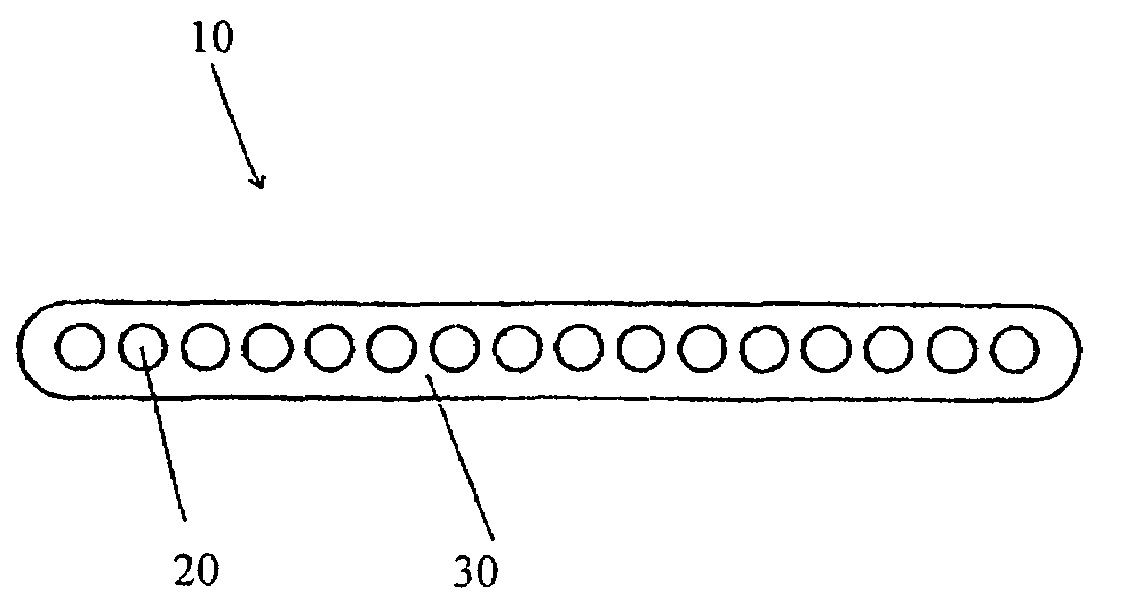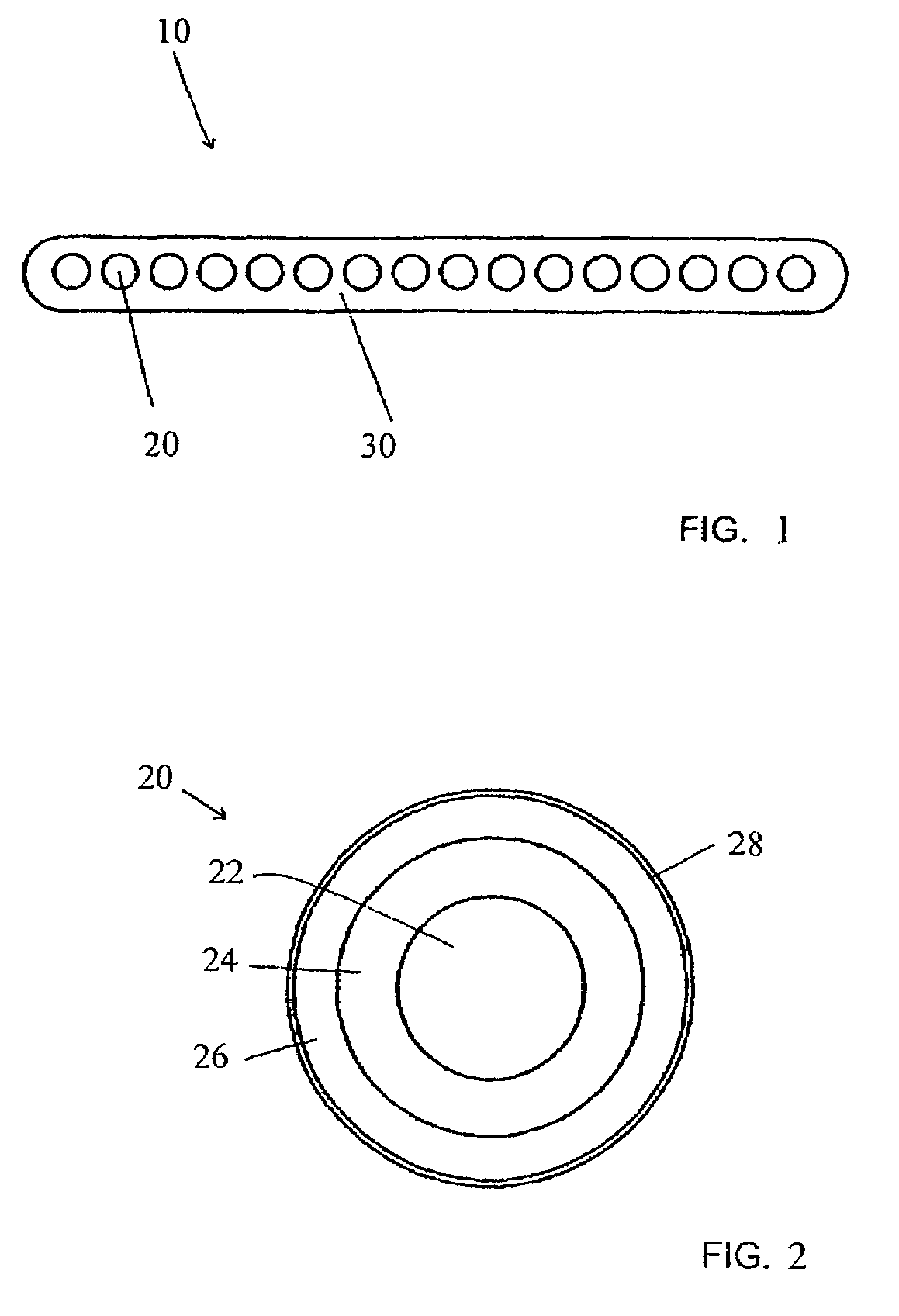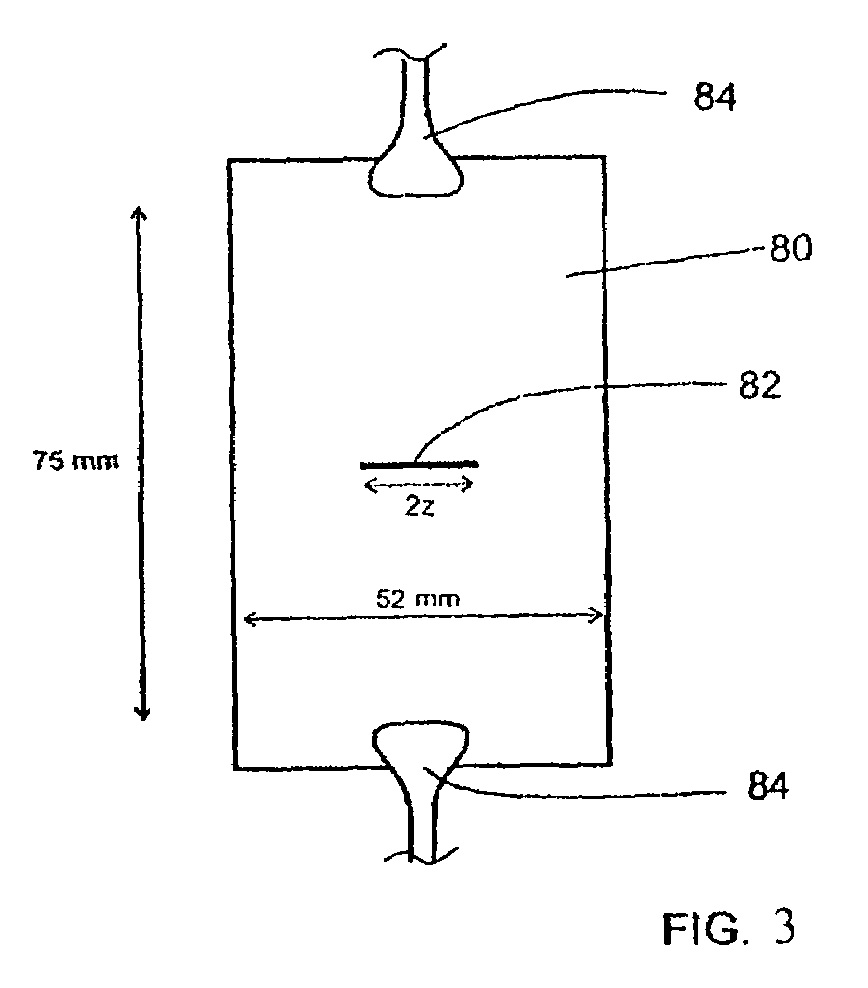Optical fiber ribbon with improved stripability
a technology of optical fiber and stripability, applied in the field of optical fiber and optical fiber ribbons, can solve the problems of poor peeling performance of the ribbon, difficulty in obtaining a fast cure speed, and increased surface friction
- Summary
- Abstract
- Description
- Claims
- Application Information
AI Technical Summary
Benefits of technology
Problems solved by technology
Method used
Image
Examples
example 1
Preparation of Optical Fiber Ribbons
[0084]Optical fiber ribbons were fabricated using previously prepared optical fibers that possessed either a high Tg (>60C) secondary coating (“Coating A”) or a lower Tg (<55C) secondary coating (“Coating B”). The compositions are detailed below in weight percent in Table 1, except that those ingredients listed in pph were added to the 100 percent weight of the coating.
[0085]
TABLE 1Coating CompositionsComponentCoating ACoating BPhotomer 3016 (Cognis) 20% 5%Photomer 4028 (Cognis) 77% 82%KWS4131 (Bomar) 0% 10%Lucirin TPO (BASF)1.5%1.5%Irgacure 184 (Ciba)1.5%1.5%Irganox 1035 (Ciba)0.5 pph0.5 pph
[0086]Ink compositions that were used to cover the optical fibers included either DSM-751 (“Ink A”), an ink coating commercially available from DSM Desotech, Inc. (Elgin, Ill.); Coating A, a clear ink base with no added pigment dispersions (“Ink B”), and Coating B, a clear ink base with no added pigments (“Ink C”).
[0087]While “Ink B” and “Ink C” were tested ...
example 2
Testing of Ribbons for Strip Cleanliness
[0092]All ribbons were stripped using a Sumitomo JR4A stripper set at 90° C. Stripping was performed by hand, at either subjectively defined slow or fast rates. Ribbon strip performance was evaluated with ratings assigned for both cleanliness and tube-off.
[0093]Strip cleanliness was measured by examining the stripped optical fiber for debris. As described above, a score of one (1) identifies a fiber having a low amount of debris on its surface and a score of five (5) represents a fiber having a significant amount of debris on its surface. Any score of three (3) or less was deemed to be acceptable strip cleanliness. Cleanliness measurements were obtained by visually inspecting a segment of the stripped ribbon fibers with the naked eye. Particles remaining on the stripped ribbon fibers were examined and compared to limit samples which were rated according to the following standard:
[0094]
Number of ParticlesCleanliness Rating 0–10111–20221–403>40 ...
example 3
Comparison of Marking Ink Degree of Cure and Marking Ink Cure Speed.
Ink formulations were prepared according to the compositions listed below in Table 5
[0097]
TABLE 5Inventive Ink Compositions - Fast Cure SpeedComponentVioletRedWhiteBlueBrownBlackYellowPhotomer20% 20% 20% 20% 20% 20% 20% 3016(Cognis)Photomer64.75% 64.25% 63.33% 62% 60.5% 65% 64.254028(Cognis)V-Cap / RC5%5%5%5%5%5%5%(ISP Corp)Lucirin3%3%3%3%3%3%3%TPO(BASF)Irgacure2%2%2%2%2%2%2%184 (Ciba)Irganox0.5 pph0.5 pph0.5 pph0.5 pph0.5 pph0.5 pph0.5 pph1035(Ciba)Uvitex OB0.1 pph0.1 pph0.1 pph0.1 pph0.1 pph0.1 pph0.1 pph(Ciba)Tegorad3.75 pph 3.75 pph 3.75 pph 3.75 pph 3.75 pph 3.75 pph 3.75 pph 2250(TegoChemie)9W8923.5% 1.0% 6.67% 2%1.5% 0%2.5% WhitePigmentDispersion(PennColor)9S949D1.75% 0.25% 0%0%2.0% 0%0%VioletPigmentDispersion(PennColor)9S959D0%0%0%6.0% 0%0%0%BluePigmentDispersion(PennColor)9R925 Red0%4.5%0%0%0%0%0%PigmentDispersion(PennColor)9Y8040%0%0%0%6.0%0%0%OrangePigmentDispersion(PennColor)9B3950%0%0%0%...
PUM
 Login to View More
Login to View More Abstract
Description
Claims
Application Information
 Login to View More
Login to View More - R&D
- Intellectual Property
- Life Sciences
- Materials
- Tech Scout
- Unparalleled Data Quality
- Higher Quality Content
- 60% Fewer Hallucinations
Browse by: Latest US Patents, China's latest patents, Technical Efficacy Thesaurus, Application Domain, Technology Topic, Popular Technical Reports.
© 2025 PatSnap. All rights reserved.Legal|Privacy policy|Modern Slavery Act Transparency Statement|Sitemap|About US| Contact US: help@patsnap.com



